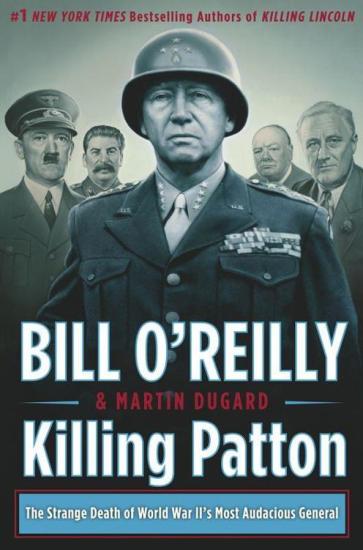
Rating: ****
Tags: Biographies & Memoirs, Historical, United States, Leaders & Notable People, Military, World War II, History, Americas, Professionals & Academics, Military & Spies, 20th Century, Lang:en
Summary
Readers around the world have thrilled to
Killing Lincoln, Killing Kennedy, and
Killing Jesus--riveting works of nonfiction that
journey into the heart of the most famous murders in history.
Now from Bill O’Reilly, anchor of
The O’Reilly Factor, comes the most epic book
of all in this multimillion-selling series:
Killing Patton. General George S. Patton, Jr. died under mysterious
circumstances in the months following the end of World War
II. For almost seventy years, there has been suspicion that
his death was not an accident--and may very well have been an
act of assassination.
Killing Patton takes readers inside the final year
of the war and recounts the events surrounding Patton’s
tragic demise, naming names of the many powerful individuals
who wanted him silenced. In
Killing Patton: The Strange Death of World War II’s
Most Audacious General, Bill O’Reilly and Martin
Dugard have written a lively, provocative account of the
death of General George S. Patton and the important events in
the final year of the Allied victory in Europe, which
Patton’s brilliant generalship of the American Third
Army did so much to secure. The fourth book in the bestselling Killing series is rich
in fascinating details, and riveting battle scenes. The
authors have written vivid descriptions of a compelling cast
of characters, major historical figures such as Eisenhower,
Churchill, Roosevelt, Stalin, Hitler, and others, as well as
more obscure players in the great drama of the Second World
War and the life and death of Patton. O’Reilly and Dugard express doubts about the
official explanation for Patton’s demise from injuries
he suffered in an automobile accident. They surmise that the
General’s outspokenness about his controversial views
on postwar security, particularly his animosity toward the
Soviets, our erstwhile allies, might have made him a target
for assassination. They cast a suspicious eye toward various
potential culprits from Josef Stalin to wartime espionage
czar “Wild Bill” Donovan and a colorful OSS
operative, Douglas Bazata, who claimed later in life to have
murdered Patton. Certainly, there are a number of curious circumstances
that invite doubt and speculation, Bazata’s admission
for one. Or that the drunken sergeant who drove a likely
stolen truck into Patton’s car inexplicably was never
prosecuted or even reprimanded. But whether you share their
suspicions or not this is popular history at its most
engrossing. From accounts of the terribly costly battle for Fort
Driant in the hills near Metz to the Third Army’s
crowning achievement, its race to relieve the siege of
Bastogne in the Battle of the Bulge, the reader experiences
all the drama of the “great crusade” in its
final, thrilling months. The authors’ profiles of world leaders and
Patton’s contemporaries are economic but manage to
offer fresh insights into the personalities of well-known
men. Just as compelling are the finely wrought sketches of
people of less renown but who played important parts in the
events. There is PFC Robert Holmund, who fought and died
heroically at Fort Driant having done all he could and then
some to take his impossible objective. PFC Horace Woodring,
Patton’s driver, who revered the general, went to his
grave mystified by the cause and result of the accident that
killed his boss. German Field Marshall Erwin Rommel’s
young son, Manfred, exchanged a formal farewell handshake
with him after learning his father would be dead in a quarter
hour, having been made to commit suicide to prevent the death
and dishonor of his family. These and many other captivating accounts of the personal
and profound make
Killing Patton a pleasure to read. I enjoyed it
immensely and highly recommend it to anyone with an interest
in World War II history and the extraordinary man who claimed
Napoleon’s motto, “audacity, audacity, always
audacity,” as his own. Bill O'Reilly is the anchor of The O'Reilly Factor, the
highest-rated cable news show in the US. He also writes a
syndicated newspaper column and is the author of several
number-one bestselling books, including Killing Jesus,
Killing Kennedy, and Killing Lincoln. Martin Dugard is the
New York Times bestselling author of several books of
history. His book Into Africa: The Epic Adventures of Stanley
and Livingstone has been adapted into a History Channel
special. He lives in Southern California with his wife and
three sons.Amazon.com Review
Amazon Exclusive: Senator John McCain Reviews
Killing Patton
About the Author